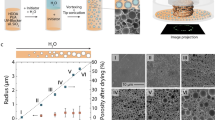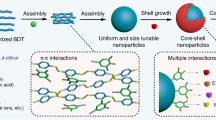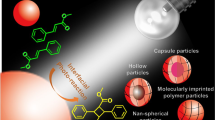Abstract
Colloidal particles with hollow interiors play important roles in microencapsulation—a process that has found widespread use in applications such as controlled release of drugs, cosmetics, inks, pigments or chemical reagents; protection of biologically active species; and removal of pollutants1,2,3,4,5. The hollow particles are most commonly prepared by coating the surfaces of colloidal templates with thin layers of the desired material (or its precursor), followed by selective removal of the templates by means of calcination or chemical etching5. This simple and straightforward approach works for a variety of materials that include polymers, ceramics, composites and metals5,6,7,8,9,10,11,12,13,14. For polymers, methods such as emulsion polymerization, phase separation, crosslinking of micelles and self-assembly have also been demonstrated for generating hollow structures15,16,17,18,19,20. However, diffusion through these closed shells with pores <10 nm is often a slow process. To solve this problem, macroporous capsules have been fabricated by organizing colloids around liquid droplets to form colloidosomes or by controlling the mixing of liquid droplets21,22,23. Here we report the preparation of another class of macroporous capsules—polymer shells with controllable holes in their surfaces. After loading of functional materials, the holes can be closed by means of thermal annealing or solvent treatment.
This is a preview of subscription content, access via your institution
Access options
Subscribe to this journal
Receive 12 print issues and online access
$259.00 per year
only $21.58 per issue
Buy this article
- Purchase on Springer Link
- Instant access to full article PDF
Prices may be subject to local taxes which are calculated during checkout




Similar content being viewed by others
References
Wilcox, D. L., Berg, M., Bernat, T., Kellerman, D. & Cochran, J. K. Jr. Hollow and solid spheres and microspheres: Science and technology associated with their fabrication and application. Mater. Res. Soc. Symp. Proc. 372, 1–13 (1994).
Langer, R. Drug delivery and targeting. Nature 392 (suppl.), 5–10 (1998).
Bergbreiter, D. E. Self-assembled, sub-micrometer diameter semipermeable capsules. Angew. Chem. Int. Edn Engl. 38, 2870–2872 (1999).
White, S. R. et al. Autonomic healing of polymer composites. Nature 409, 794–797 (2001).
Caruso, F. Nanoengineering of particle surfaces. Adv. Mater. 13, 11–22 (2001).
Kawahashi, N. & Matijević, E. Preparation and properties of uniform coated colloidal particles: V. Yttrium basic carbonate on polystyrene latex. J. Colloid Interface Sci. 138, 534–542 (1990).
Caruso, F., Caruso, R. A. & Möhwald, H. Nanoengineering of inorganic and hybrid hollow spheres by colloidal templating. Science 282, 1111–1114 (1998).
Zhong, Z., Yin, Y., Gates, B. & Xia, Y. Preparation of mesoscale hollow spheres of TiO2 and SnO2 by templating against crystalline arrays of polystyrene beads. Adv. Mater. 12, 206–209 (2000).
Marinakos, S. M. et al. Gold particles as templates for the synthesis of hollow polymer capsules: Control of capsule dimensions and guest encapsulation. J. Am. Chem. Soc. 121, 8518–8522 (1999).
Von Werne, T. & Patten, T. E. Preparation of structurally well-defined polymer-nanoparticle hybrids with controlled/living radical polymerizations. J. Am. Chem. Soc. 121, 7409–7410 (1999).
Fleming, M. S., Mandal, T. K. & Walt, D. R. Nanosphere-microsphere assembly: methods for core-shell materials preparation. Chem. Mater. 13, 2210–2216 (2001).
Jackson, J. B. & Halas, N. J. Silver nanoshells: variations in morphologies and optical properties. J. Phys. Chem. B 105, 2743–2746 (2001).
Cohen, I., Li, H., Hougland, L., Mrksich, M. & Nagel, S. R. Using selective withdrawal to coat microparticles. Science 292, 265–267 (2001).
Kamata, K., Lu, Y. & Xia, Y. Synthesis and characterization of monodispersed core-shell spherical colloids with movable cores. J. Am. Chem. Soc. 125, 2384–2385 (2003).
Pekarek, K. J., Jacob, J. S. & Mathiowitz, E. Double-walled polymer microspheres for controlled drug release. Nature 367, 258–260 (1994).
Huang, H., Remsen, E. E., Kowalewski, T. & Wooley, K. L. Nanocages derived from shell cross-linked micelle templates. J. Am. Chem. Soc. 121, 3805–3806 (1999).
Wong, M. S., Cha, J. N., Choi, K. -S., Deming, T. J. & Stucky, G. D. Assembly of nanoparticles into hollow spheres using block copolypeptides. Nano Lett. 2, 583–587 (2002).
Hentze, H. -P. & Kaler, E. W. Polymerization of and within self-organized media. Curr. Opin. Colloid Interface Sci. 8, 164–178 (2003).
Pochan, D. J. et al. Toroidal triblock copolymer assemblies. Science 306, 94–97 (2004).
Li, Z., Kesselman, E., Talmon, Y., Hillmyer, M. A. & Lodge, T. P. Multicompartment micelles from ABC miktoarm stars in water. Science 306, 98–101 (2004).
Velev, O. D., Furusawa, K. & Nagayama, K. Assembly of latex particles by using emulsion droplets as templates. 1. microstructured hollow spheres. Langmuir 12, 2374–2384 (1996).
Dinsmore, A. D. et al. Colloidosomes: Selectively permeable capsules composed of colloidal particles. Science 298, 1006–1008 (2002).
Fialkowski, M., Bitner, A. & Grzybowski, B. A. Self-assembly of polymeric microspheres of complex internal structures. Nature Mater. 4, 93–97 (2005).
Danbert, T. E. & Danner, R. P. Physical and Thermodynamic Properties of Pure Chemicals: Data Compilation Vol. 3 (Hemisphere, New York, 1989).
Kim, J. H., Chainey, M., El-Aasser, M. S. & Vanderhoff, J. W. Emulsifier-free emulsion copolymerization of styrene and sodium styrene sulfonate. J. Polym. Sci. Polym. Chem. 30, 171–183 (1992).
Skjeltorp, A. T., Ugelstad, J. & Ellingsen, T. Preparation of nonspherical, monodisperse polymer particles and their self-organization. J. Colloid Interface Sci. 113, 577–582 (1986).
Van Krevelen, D.W. Properties of Polymers: Their Correlation with Chemical Structures 189–225 (Elsevier Science, New York, 1990).
Han, M., Gao, X., Su, J. Z. & Nie, S. Quantum-dot-tagged microbeads for multiplexed optical coding of biomolecules. Nature Biotechnol. 19, 631–635 (2001).
Xia, Y., Yin, Y., Lu, Y. & McLellan, J. Template-assisted self-assembly of spherical colloids into complex and controllable structures. Adv. Funct. Mater. 13, 907–918 (2003).
Ahmad, A. & Salahuddin, A. Effect of organic solvents on Lysozyme-Antilysozyme precipitin reaction. Comp. Biochem. Physiol. C 114, 119–121 (1996).
Acknowledgements
This work was supported in part by an AFOSR-MURI grant on smart skin materials awarded to the University of Washington and a fellowship from the David and Lucile Packard Foundation. Y.X. is a Camille Dreyfus Teacher Scholar (2002–2007). S.H.I. and U.J. were also partially supported by the Post-Doctoral Fellowship Program of the Korean Science and Engineering Foundation (KOSEF). This work used the Nanotech User Facility at the University of Washington, a member of the National Nanotechnology Infrastructure Network funded by the NSF.
Author information
Authors and Affiliations
Corresponding author
Ethics declarations
Competing interests
The authors declare no competing financial interests.
Supplementary information
Supplementary Information
Supplementary figures S1 and S2; supplementary table S1 (PDF 106 kb)
Rights and permissions
About this article
Cite this article
Hyuk Im, S., Jeong, U. & Xia, Y. Polymer hollow particles with controllable holes in their surfaces. Nature Mater 4, 671–675 (2005). https://doi.org/10.1038/nmat1448
Received:
Accepted:
Published:
Issue Date:
DOI: https://doi.org/10.1038/nmat1448
This article is cited by
-
The development of hollow multishelled structure: from the innovation of synthetic method to the discovery of new characteristics
Science China Chemistry (2022)
-
Hierarchical polymeric hollow microspheres with size tunable single holes and their application as catalytic microreactor
Colloid and Polymer Science (2022)
-
Static-state particle fabrication via rapid vitrification of a thixotropic medium
Nature Communications (2021)
-
Transmembrane transport in inorganic colloidal cell-mimics
Nature (2021)
-
Magneto-structural and photocatalytic behavior of mixed Ni–Zn nano-spinel ferrites: visible light-enabled active photodegradation of rhodamine B
Journal of Materials Science: Materials in Electronics (2020)



